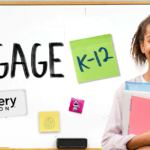By Hillary Goldthwait-Fowles
The past month has shaken up education
In fact, it’s shaken up everyone’s way of life in some way. All of a sudden, schools were forced to shutter their doors amid COVID-19, leaving parents, teachers and administrators scrambling to provide learning in alternate ways to all students. Some were wondering how to “recreate school,” while others were excited for the opportunity to “redesign school” using a mix of technology and real-world applications to concepts.
What has emerged from all of this chaos? Some fundamental truths, some challenges, and a lot of discomfort.
That’s the thing about growth – it’s a cycle
Like that infamous disco hit “I Will Survive,” Gloria Gaynor was, at first- afraid. In fact she was petrified. Yet then she learned that she was strong, and she learned how to get along. In essence, she survived. She tackled the challenge of a crisis in her life, learned from it, and not only survived- she thrived!
However, these cycles of growth amid crisis may not be accessible to all. This crisis has cast a harsh, honest glare on the gross inequities of our systems and services. Whether it’s an inequity based on socioeconomic status, living situation, race, sexual orientation, or disability, these inequities have existed since our systems were born.
They’re wrong.
It needs to stop. This crisis has brought to us a powerful call to change. If you grew up in the era of the Brady Bunch, you’ll remember Peter Brady singing about “Time to Change.”
Regarding our systems in education shifting to distance learning, a glaring inequality has been identified around device and internet access. Far too many families do not have internet access, nor a device per child. There are cases where districts have offered wifi hotspots to families, however not every district is prepared or has funds to provide these devices. Some families are driving to schools and using their network to work and learn.
Is that fair? Is that equitable? Is this crisis telling us that accessibility to the internet is a human right?
I’m not the only one who is wondering this
Organizations have been speaking about this inequity since 1990. CoSN (the Consortium for School Networking), stated in 2018 that:
“Students who do not have access to high-quality internet connectivity are at a disadvantage, unable to realize the power of digital learning. Only 3% of teachers in high-poverty areas said that students had the digitally accessible tools to complete homework, compared to 52% in more affluent school systems.” (CoSN, 2018).
They launched their Digital Equity Initiative to support equitable access to broadband internet. 24/7.
Another organization that is championing this work is the National Digital Inclusion Alliance, who had been working to shed light on this inequity prior to COVID-19. They work in places where internet access isn’t available and provide resources and support and continue to do so around the clock.
 What both of these organizations have shown, and the COVID-19 pandemic has emphasized, is that high-speed internet access is a basic human right that should be made readily available to all. Schools have shifted to online and distance learning. Access should not be based on socioeconomic status, race, gender, orientation, or ability. It should be as fundamental as the air we breathe.
What both of these organizations have shown, and the COVID-19 pandemic has emphasized, is that high-speed internet access is a basic human right that should be made readily available to all. Schools have shifted to online and distance learning. Access should not be based on socioeconomic status, race, gender, orientation, or ability. It should be as fundamental as the air we breathe.
Speaking of the internet, it is ESSENTIAL that websites, materials, methods, and assessments are born accessible. This means that videos should have closed captioning, transcripts. Image descriptions should be provided, as well as alternative text for images. The w3c (World Wide Web Consortium) provided clear guidance to web designers and services on designing for accessibility first. The AEM Center (National Center on Accessible Instructional Materials) and CAST (Center for Applied Special Technology) provides guidance based on the principles of Universal Design for Learning (UDL) which is framework that proactively plans for variability by providing options, choices, and flexibility to all learners first and not after. This is another form of access for all learners that distance learning amid COVID-19 is begging for.
Given our state of affairs, a light on inequity has been cast
It is up to those who are privileged to no longer ignore the call but to flip this script. This crisis has shown us that internet access for all is a human right, and we must find creative, accessible solutions to answer the call. Following the guidance from CoSN, NDIA, W3C, CAST and AEM Center in order to provide meaningful and equitable access for all are important steps toward that goal. These resources have been around for decades. When we re-emerge from this time, may we have worked collectively to shift the paradigm from power to empowered for all.
Hillary Goldthwait-Fowles, PhD., ATP, is an accessibility accomplice providing assessment, training, support, and consultation to individuals and organizations around AT, AEM, and UDL. She is an Assistive Technology Specialist for RSU 21 in Kennebunk, Maine where she is grateful to “be paid to think differently” and supports inclusive learning practices. She is also an adjunct faculty member for the University Of New England’s graduate certification programs in inclusion, as well as the University of Maine at Farmington’s graduate programs in Inclusion.
The American Consortium for Equity in Education, publisher of the "Equity & Access" journal, celebrates and connects the educators, associations, community partners and industry leaders who are working to solve problems and create a more equitable environment for historically underserved pre K-12 students throughout the United States.
- American Consortium for Equity in Educationhttps://ace-ed.org/author/admin/
- American Consortium for Equity in Educationhttps://ace-ed.org/author/admin/April 23, 2025
- American Consortium for Equity in Educationhttps://ace-ed.org/author/admin/
- American Consortium for Equity in Educationhttps://ace-ed.org/author/admin/







